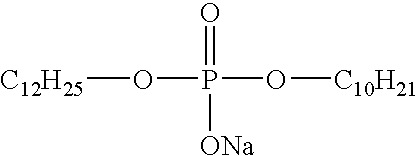Solution of cellulose acylate dissolved in mixed solvent of ketone and ester
a technology of acylate and solvent, which is applied in the field of solution of cellulose acylate dissolved in the mixed solvent of ketone and ester, can solve the problems of poor storage stability, unsatisfactory all, and the use of chlorinated solvents such as methylene chloride has been recently restricted severely to protect the global environmental conditions, etc., and achieves excellent storage stability.
- Summary
- Abstract
- Description
- Claims
- Application Information
AI Technical Summary
Benefits of technology
Problems solved by technology
Method used
Image
Examples
example 1
(1-1) Preparation of Cellulose Acylate Solution
[0132]Cellulose acylate solutions were prepared according to the following two methods. The components of the solution prepared in each example or comparison example were shown in Table 1 in detail. To each solution, silica particles (size: 20 nm), triphenylphosphate / biphenyldiphenylphosphate (1 / 2, by weight) and 2,4-bis-(n-octylthio)-6-(4-hydroxy-3,5-di-tert-butylanilino)-1,3,5-triazine were added in the amounts of 0.5 wt. %, 10 wt. % and 1.0 wt. %, respectively, based on the amount of cellulose acylate. Further, releasing agents shown in Table 1 were added.
[0133]In the swelling step and the dissolving step, the temperature of solvent and the time for swelling were changed. Those conditions were also shown in Table 2 in detail.
(1-1a) Cooling Dissolution Method (Represented by “Cool” in Table 1)
[0134]To the solvent, each cellulose acylate shown in Table 1 was gradually added while stirred. The mixture was left at room temperature (25° C...
example 2
(1-1) Preparation of Cellulose Triacetate Solution
[0149]A cellulose triacetate solution was prepared in the following manner. In a 2L stainless steel-made dissolution tank equipped with a stirring propeller, a mixture consisting of the below-described components was placed. (The tank was beforehand washed well with methylene chloride.) With the mixture vigorously stirred, powder of cellulose triacetate (mean particle size: 2 mm) was gradually added to make the total weight 1 kg. The mixture was then left at room temperature (25° C.) for 3 hours, so as to swell the cellulose triacetate.
[0150]
Cellulose triacetate (substitution degree: 2.83, water20weight partscontent: 0.4 wt %, viscosity average degree of poly-merization: 320, viscosity of 6 wt. % methylenechloride solution: 305 mPa · s)Methyl acetate48weight partsCyclopentanone10weight partsMethanol5weight partsEthanol5weight partsDipentaerythritol hexaacetate (plasticizer A)6weight partsTriphenyl phosphate (plasticizer B)6weight par...
example 3
[0155]The process for preparing the sample 1-3 of Example 2 was repeated except that the cellulose triacetate solution of (1-2) was treated in the following manner, to prepare the sample 2-3.
[0156]The inhomogeneous cellulose triacetate solution of (1-2) in the form of gel was sent by means of a screw pump, to pass through a heating path heated and pressed at 180° C. and 1 Mpa, respectively. In the heating path, the solution was heated and pressed to 110° C. and 1 Mpa for 3 minutes, and then filtrated through filter paper having the absolute filtration precision of 0.01 mm (#63, Toyo Filter Co., Ltd.) and further filtrated through filter paper having the absolute filtration precision of 0.0025 mm (FHO25, Pole).
(2-1) Results
[0157]The prepared sample 2-3 of the invention was excellent in filtration, and left no flake on the support when peeled off. Further, the film made of the sample was excellent in unevenness, warts and haze. Thus, it was confirmed that the present invention could g...
PUM
| Property | Measurement | Unit |
|---|---|---|
| temperature | aaaaa | aaaaa |
| temperature | aaaaa | aaaaa |
| boiling point | aaaaa | aaaaa |
Abstract
Description
Claims
Application Information
 Login to View More
Login to View More - R&D
- Intellectual Property
- Life Sciences
- Materials
- Tech Scout
- Unparalleled Data Quality
- Higher Quality Content
- 60% Fewer Hallucinations
Browse by: Latest US Patents, China's latest patents, Technical Efficacy Thesaurus, Application Domain, Technology Topic, Popular Technical Reports.
© 2025 PatSnap. All rights reserved.Legal|Privacy policy|Modern Slavery Act Transparency Statement|Sitemap|About US| Contact US: help@patsnap.com


